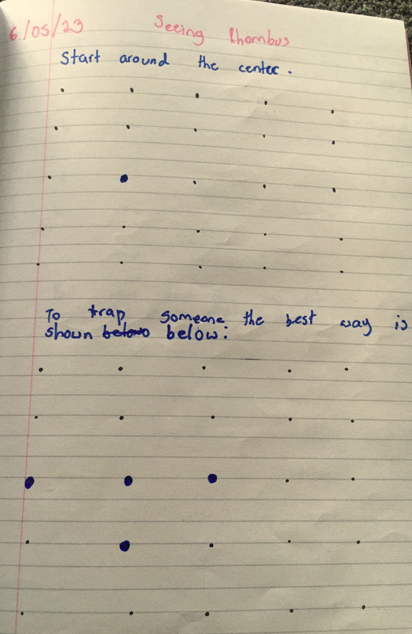Or search by topic
Number and algebra
Geometry and measure
Probability and statistics
Working mathematically
Advanced mathematics
For younger learners
Seeing Rhombuses



- Problem
- Getting Started
- Student Solutions
- Teachers' Resources
Thank you to everybody who sent in their ideas about this game. Most people found that the easiest way to win was by making a square, which is a special type of rhombus, so the solutions are very similar to the solutions for Seeing Squares.
Dhruv at The Glasgow Academy in the UK sent in this image:

Dhruv said:
I decide where to place my dot depending on what the opponent plays. You can beat the computer if it goes first but it is difficult.
Thank you for sharing these ideas with us, Dhruv. I can see lots of ways that you can win from the position in the picture!
William described a similar strategy, and explained where the computer would make its moves:
Place 3 dots in a row on the second line (just below the first line)
The computer will make its move under/on top of the middle shape
Then you have to place your move on the opposite the computer made (up or down the middle dot)
The computer will try to prevent your move by going left or right
You make your move the opposite where the computer made, and you now have a victory.
This is a good strategy - we were also sent similar explanations by Hogan at Banstead Prep School and Sebastian at The British School Al Khubairat in UAE.
We received a few solutions from the children at The British School Al Khubairat. Charlie explained a strategy which relied on making triangles:
I tried many approaches, however, in my most useful method, I tried to create triangles (which I would later make into a rhombus). Making many triangles allows ways you can change your shape to allow the shape of a rhombus.

Can you see the triangles that Charlie has made in this solution? I wonder if there is a way to adapt this strategy to make non-square rhombuses?
Shafin had a similar idea that also involved making triangles:
If you do 1, then 2, then 3, then you will force the computer to go to 6. Then, you should go to 4 so you trap the computer. Finally, go to the remaining dot to win!

Thank you all for sharing these ideas with us.
You may also like
Bracelets
Investigate the different shaped bracelets you could make from 18 different spherical beads. How do they compare if you use 24 beads?
Cut and Make
Cut a square of paper into three pieces as shown. Now,can you use the 3 pieces to make a large triangle, a parallelogram and the square again?
Is a Square a Rectangle?
How many rectangles can you find in this shape? Which ones are differently sized and which are 'similar'?

